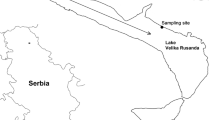Abstract
Amarga Lagoon, lat. 50°29′ S and long. 73°45′ S, it is located at the Torres del Paine National Park, Chile. The physical, chemical, and biological features of the lake were studied. According to salinity, the lake is mesosaline. Sodium and chloride were the dominant ions. Nitrogen was potentially limiting for phytoplankton growth. One Cyanophyceae species andArtemia were the predominant species in the plankton.Artemia provided abundant food for flamingoes.
Similar content being viewed by others
References
APHA. 1980. Standard Methods for the Examination of Water and Waste-water. American Public Health Association, New York.
Beadle, L.C. 1943. Osmotic regulation and the faunas of inland water. Biological Reviews 18: 172–183.
Campos, H. 1984. Limnological study of Araucanian lakes (Chile). Verhandlungen Internationale Vereinigung Limnologie 22: 1319–1327.
Campos, H., Soto, D., Steffen, W., Parra, O., Aguero, G. and Zuñiga, L. 1994. Limnological study of lake Sarmiento (Chile): a subsaline lake from Chilean patagonian of South America. Archiv für Hydrobiologie, Suppl. 99 (1/2): 217–234.
Chong, G. 1984. Die Salare in Nordchile. Geologie, Strucktur und Geochemie. Geatekt Forsch. 67: 1–146, Stuttgart.
Chong, G. 1988: The Cenozoic saline of the Chilean Andes between 18°00′ and 27°00′ South latitude. In: H. Bahlburg and Ch. Breitkrenz (Eds) The Southern Centrales Andes. Vol. 17, Lecture Notes in Earth Sciences, Springer-Verlag, Heidelberg.
Cooper, S.D., Winkler, D.W. and Lenz, P.H. 1984. The effect of grebe predation on a brine shrimp population. Journal of Animal Ecology 53: 51–64.
Dejoux, C. 1993. Benthic invertebrates of some saline lakes of the Sud Lipez Region, Bolivia. Hydrobiologia 267: 257–267.
Hammer, U.T. 1978. The saline lakes of Saskatchewan. III. Chemical characterization. International Revue gesamten Hydrobiologie 63: 311–335.
Hammer, U.T. 1986. Saline lakes: distribution and uses. In: D.T. Waite (Ed) Evaluating Saline Waters in a Plains Environment. Canadina Plains Proceedings 17, pp. 1–22.
Hammer, U.T. and Parker, R.D. 1984. Limnologie of a perturbed highly saline Canadian lake. Archiv für Hydrobiologie 102: 31–42.
Hammer, U.T., Shamess, J., and haynes, R.C. 1983. The distribution and abundance of algae in saline lakes os Saskatchewan, Canada. Hydrobiologia 16: 1–26.
Hurlbert, S.J., Loayza, W. and Moreno, T. 1986. Fish-flamingo-plankton interaction in the Peruvian Andes. Limnology and Oceanography 31: 457–468.
Hutchinson, G.E. 1957. A Treatise on Limnology. Vol. I. Geography, Physics and Chemistry. Wiley, New York.
Melack, J.M. 1983. Large deep salt lakes: A comparative limnological analysis. Hydrobiologia 105: 223–230.
Saijo, Y., Mitamura, O., and Tanaka, M. 1995. A note on the chemical composition of lake waters in Laguna Amarga, a saline lake in Patagonia, Chile. International Journal of Salt Lake Research 4(2): 165–167.
SCOR-UNESCO. 1969. Determination of Photosynthetic Pigments in Sea Water. 2nd Ed. Imprimeire Rolland, Paris.
Slack, K.V., Averett, C., Greeson, P.E. and Lipscomb, R.R. 1973. Methods for collection and analysis of aquatic biological and microbiological samples. Techniques of water resource investigations of the United State Geol. Surv. Books Lab. Anal., Washington, DC.
Soto, D. 1991. Relationships between zooplankton biomass and Chilean flamingo populations in Chilean Patagonic lagoons. In: G. Parada, J. Rottman and G. Guerra (Eds) First International Workshop for Specialists on South American Flamingos. Corporacion Nacional Forstal, Santiago, Chile and New York.
Soto, D., Campos, H., Steffen, W., Parra, O. and Zuñiga, L. 1994. Limnology of the Torres del Paine lake district (Chilean Patagonia): a case of pristine N-limited lakes and ponds. Archiv für Hydrobiologie, Suppl. 99: 181–197.
Strickland, J.D.H. and Parson, T.R. 1972. A Manual of Seawater Analysis (with Special Reference to the More Common Nutrients and to Particulate Organic Material). Fisheries Research Board of Canada, Bulletin No. 125 (second edition, revised), Ottawa.
Vila, T. 1976. Modelo de distribución y origen de algunos elementos en salmuera de dépositos salinos andinos, Norte de Chile. Acta Primer Congreso Geológico, Chileno, tomo II:65–82. Santiago, Chile.
Utermohl, H. 1958. Zur Vervollkommung der quantitativen Phytoplankton-Methodik. Mitteilungen Internationale Vereinigung für Limnologie 9: 1–38.
Williams, W.D. 1964. A contribution to lake typology in Victoria, Australia. Verhandlungen Internationale Vereinigung für Limnologie 15: 158–163.
Williams, W.D., Carrick, T.R., Bayly, I.A.E., Green, J. and Herbst, D.B. 1995. Invertebrates of salt lakes of the Bolivian Altiplano. International Journal of Salt Lake Research 4 (1): 65–77.
Author information
Authors and Affiliations
Rights and permissions
About this article
Cite this article
Campos, H., Soto, D., Parra, O. et al. Limnological studies of Amarga Lagoon, Chile: A saline lake in Patagonian South America. International Journal of Salt Lake Research 4, 301–314 (1995). https://doi.org/10.1007/BF01999114
Issue Date:
DOI: https://doi.org/10.1007/BF01999114




